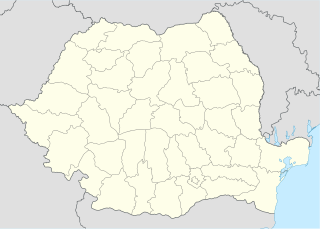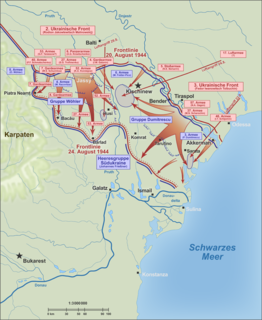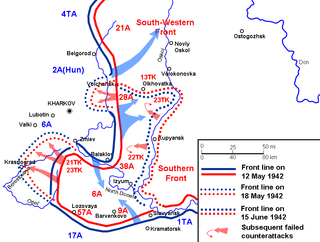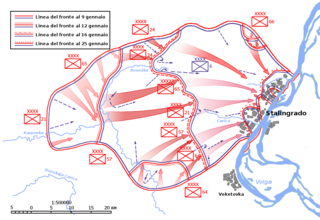 W
WThe Battle of the Sea of Azov, also known as the Chernigovka pocket was an Axis military campaign fought between 26 September 1941 and 11 October 1941 on the northern shores of the Sea of Azov on the Eastern Front of World War II during Operation Barbarossa. It resulted in a complete Axis victory over the Red Army.
 W
WThe Bratislava–Brno offensive was an offensive conducted by the Red Army in western Slovakia and south Moravia towards the end of World War II. The offensive was held between 25 March and 5 May 1945 using the forces of the 2nd Ukrainian Front to capture the capital of Slovakia, Bratislava, and the capital of Moravia, Brno.
The siege of Budapest or Battle of Budapest was the 50-day-long encirclement by Soviet and Romanian forces of the Hungarian capital of Budapest, near the end of World War II. Part of the broader Budapest Offensive, the siege began when Budapest, defended by Hungarian and German troops, was encircled on 26 December 1944 by the Red Army and the Romanian Army. During the siege, about 38,000 civilians died through starvation or military action. The city unconditionally surrendered on 13 February 1945. It was a strategic victory for the Allies in their push towards Berlin.
 W
WThe Battle of Carei was the last stage of recovering Romania's former territory of Northern Transylvania, ceded in 1940 to Hungary as a result of the Second Vienna Award. The battle occurred towards the end of World War II, in the wider context of the Battle of Romania and the Battle of Debrecen. On October 25, 1944, the cities of Carei and Satu Mare were freed from Hungarian and German control. By a decree from 1959, this day was established as the Romanian Armed Forces Day.
 W
WThe Battle of Debrecen, called by the Red Army the Debrecen Offensive Operation, was a battle taking place 6–29 October 1944 on the Eastern Front in Hungary during World War II.
 W
WThe Skirmish at Diosig was a border incident between troops of the Kingdom of Romania and the Kingdom of Hungary in September 1940.
 W
WThe first Jassy–Kishinev offensive, named after the two major cities Iași (Jassy) and Chișinău (Kishinev) in the area, was a series of military engagements between 8 April and 6 June 1944 by the Soviets and Axis powers of World War II. Richard C. Hall also refers to a first Jassy–Kishinev operation which began on 5 April, without providing an exact date for its end. According to Glantz, the purported offensive was a coordinated invasion of Romania conducted by Red Army's 2nd and 3rd Ukrainian Fronts, in accordance with Joseph Stalin's strategy of projecting Soviet military power and political influence into the Balkans.
 W
WThe second Jassy–Kishinev operation, named after the two major cities, Iași ("Jassy") and Chișinău ("Kishinev"), in the staging area, was a Soviet offensive against Axis forces, which took place in Eastern Romania from 20 to 29 August 1944 during World War II. The 2nd and 3rd Ukrainian Fronts of the Red Army engaged Army Group South Ukraine, which consisted of combined German and Romanian formations, in an operation to reoccupy Bessarabia and destroy the Axis forces in the region, opening the way into Romania and the Balkans.
 W
WThe Kerch–Eltigen operation was a World War II amphibious offensive made in November 1943 by the Red Army as a precursor to the Crimean offensive, with the object of defeating and forcing the withdrawal of the German forces from the Crimea. Landing at two locations on the Crimea's eastern coast, the Red Army successfully reinforced the northern beachhead of Yenikale but was unable to prevent an Axis counterattack that collapsed the southern beachhead at Eltigen. Subsequently, the Red Army used the beachhead at Yenikale to launch further offensive operations into the Crimea in May 1944.
 W
WThe Second Battle of Kharkov or Operation Fredericus was an Axis counter-offensive in the region around Kharkov against the Red Army Izium bridgehead offensive conducted 12–28 May 1942, on the Eastern Front during World War II. Its objective was to eliminate the Izium bridgehead over Seversky Donets or the "Barvenkovo bulge" which was one of the Soviet offensive's staging areas. After a winter counter-offensive that drove German troops away from Moscow but depleted the Red Army's reserves, the Kharkov offensive was a new Soviet attempt to expand upon their strategic initiative, although it failed to secure a significant element of surprise.
 W
WOperation Koltso was the last part of the Battle of Stalingrad. It resulted in the capitulation of the remaining Axis forces encircled in the city.
 W
WThe Battle of Păuliș took place in September 1944 in Arad County, western Romania as part of the wider Battle of Romania of World War II. It was fought between Hungarian and Romanian troops, after the King Michael's Coup had put Romania on the side of the Allies. The Romanians fought off persistent and heavy Hungarian attacks for 4 days. With the arrival of Soviet reinforcements they counter-attacked and pushed the Hungarians back to their original positions.
 W
WThe Battle of Romania in World War II comprised several operations in or around Romania in 1944, as part of the Eastern Front, in which the Soviet Army defeated Axis forces in the area, Romania changed sides, and Soviet and Romanian forces drove the Germans back into Hungary.
 W
WThe Battle of Rostov (1941) was a battle of the Eastern Front of World War II, fought around Rostov-on-Don between the Army Group South of Nazi Germany and the Southern Front of the Soviet Union.
 W
WIn the Battle of Stalingrad, Germany and its allies fought the Soviet Union for control of the city of Stalingrad in Southern Russia. Marked by fierce close-quarters combat and direct assaults on civilians in air raids, it is one of the bloodiest battles in the history of warfare, with an estimated 2 million total casualties. After their defeat at Stalingrad, the German High Command had to withdraw considerable military forces from other theaters of war to replace their losses.
 W
WTwo Romanian armies, the Third and the Fourth, were involved in the Battle of Stalingrad, helping to protect the northern and southern flanks respectively, of the German 6th Army as it tried to conquer the city of Stalingrad defended by the Soviet Red Army in mid to late 1942. Overpowered and poorly equipped, these forces were unable to stop the Soviet November offensive, which punched through both flanks and left the 6th Army encircled in Stalingrad. The Romanians suffered enormous losses, which effectively ended their offensive capability on the Eastern Front for the remainder of the war.
 W
WThe First Battle of Târgu Frumos was fought during World War II between Axis powers commanded by Otto Wöhler and Soviet forces led by Ivan Konev. Historian David Glantz has described it part of a failed Soviet invasion of Romania, while Russian and German sources have described it as part of the Târgu Frumos Operation.
 W
WThe Second Battle of Târgu Frumos was a military engagement primarily between the Wehrmacht and Red Army forces in May 1944, near Iași, Romania. The battle was the main engagement of the Târgu Frumos Operation, and is often referred simply as the Battle of Târgu Frumos.
 W
WThe Battle of Uman was the World War II German offensive in Uman, Ukraine against the 6th and 12th Soviet Armies. In a three-week period, the Wehrmacht encircled and annihilated the two Soviet armies
 W
WThe Western Carpathian offensive was a successful offensive by the Red Army during World War II, that lasted from January 12 to February 18, 1945.